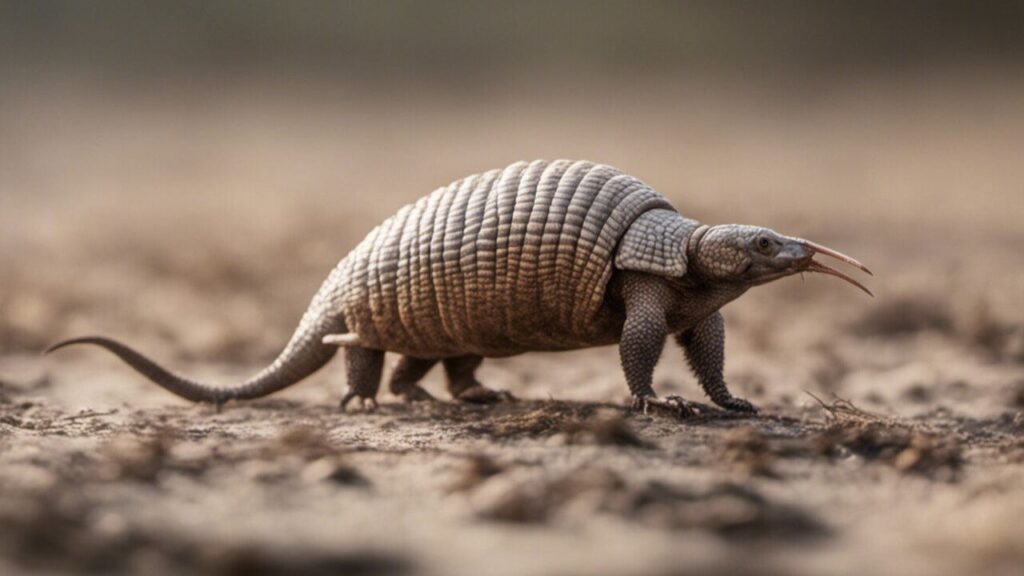Do Armadillos Attack Humans? Armadillos generally do not attack humans and are known to be shy creatures.
Armadillos are fascinating creatures, known for their distinctive armor-like shells and curious behaviors.
These nocturnal mammals are often spotted in the southern United States, particularly in Texas, and have piqued the interest of many people. One question that often arises is whether armadillos pose a threat to humans.
In this comprehensive blog post, we’ll delve into the behavior of armadillos, explore whether they attack humans, and discuss the potential risks associated with these unique animals.
Contents
What Are Armadillos?
Armadillos belong to the family Dasypodidae, and there are around 21 species of armadillos, with the nine-banded armadillo being the most common in the United States.
These animals are easily recognizable by their hard, protective shells, which are made of bony plates covered in leathery skin. This natural armor serves as a defense mechanism against predators.
Armadillos are primarily nocturnal and are known for their burrowing habits. They dig extensive networks of burrows that they use for shelter and protection.
These burrows can sometimes become a nuisance to homeowners when they are dug under buildings or in gardens. Armadillos have poor eyesight but possess a keen sense of smell, which they use to locate food.
Their diet mainly consists of insects, grubs, and other invertebrates, although they will occasionally consume small vertebrates, fruits, and plants. [Do Armadillos Attack Humans?]
Despite their tough exterior, armadillos are generally solitary and shy creatures. They are more likely to flee than fight when confronted by a threat, making them relatively non-aggressive toward humans.

Do Armadillos Attack Humans?
Understanding Armadillo Behavior
Armadillos are not naturally aggressive animals. In fact, they are known for their timid nature and will usually retreat when they sense danger. When approached by humans or other large animals, an armadillo’s first instinct is to escape.
They will often run, dig quickly into the ground, or curl into a ball (in the case of the three-banded armadillo) to protect themselves. Instances of armadillos attacking humans are exceedingly rare.
Most armadillo-human interactions occur when the animals are accidentally disturbed, such as when they are foraging for food or when their burrows are inadvertently unearthed. Even in these situations, armadillos typically try to avoid confrontation.
Circumstances That May Lead to Aggression
While armadillos are generally non-aggressive, there are a few specific circumstances where they might exhibit defensive behaviors that could be perceived as aggression:
- Feeling Cornered or Threatened: Like many animals, an armadillo may act defensively if it feels cornered or trapped. This behavior is not an attack but rather a survival instinct. An armadillo may swipe with its sharp claws or attempt to flee rapidly. However, these actions are intended to protect itself rather than to harm a human.
- Protecting Young: Female armadillos are known to be protective of their young. If a mother armadillo perceives a threat to her offspring, she may exhibit defensive behaviors. Again, this is more about self-defense than aggression toward humans.
- Handling or Capturing: Armadillos have strong, sharp claws designed for digging. If a person attempts to handle or capture an armadillo, the animal might scratch or struggle to escape. These scratches can be painful but are not typically severe. It’s important to note that handling wild animals is never recommended, as it can lead to stress and injury for both the animal and the person.
- Surprise Encounters: Occasionally, armadillos may be startled by humans or pets. In these cases, their immediate reaction might be to jump or run suddenly, which can lead to accidental scratches if they come into contact with a person. However, these incidents are generally harmless and do not constitute an attack.
Are Armadillo Attacks Dangerous?
Potential Harm from Armadillos
Although armadillos are not known for attacking humans, there are some potential risks associated with interactions with these animals. The primary concerns are related to their sharp claws and the diseases they may carry.
Armadillos use their claws for digging burrows and searching for food. These claws are strong and sharp, and while they are not used for attacking, they can cause injury if an armadillo scratches a person in self-defense.
These scratches are typically minor but can become infected if not properly cleaned and treated. [Do Armadillos Attack Humans?]
Health Risks and Precautions
One of the most well-known risks associated with armadillos is their potential to carry Mycobacterium leprae, the bacteria that cause leprosy (Hansen’s disease). While the risk of contracting leprosy from an armadillo is extremely low, it is not zero.
The transmission of leprosy from armadillos to humans is rare and usually occurs in cases where there is prolonged and close contact, such as handling or consuming the meat of an infected animal.
In addition to leprosy, armadillos can also carry other diseases, such as Salmonella and rabies, although these are much less common.
The likelihood of contracting any disease from an armadillo is very low, but it is still important to exercise caution when dealing with wildlife.
Precautionary Measures
- Avoid Handling Armadillos: The best way to prevent injury or disease is to avoid handling armadillos. If you encounter one, observe from a distance and do not attempt to touch or capture it. [Do Armadillos Attack Humans?]
- Use Protective Gear: If you must handle an armadillo (for example, if it has entered your home or garden), use thick gloves and take precautions to minimize direct contact.
- Clean and Disinfect Wounds: If you are scratched or bitten by an armadillo, clean the wound thoroughly with soap and water and apply an antiseptic. Seek medical attention if the wound shows signs of infection or if you have concerns about disease transmission.
- Report Unusual Behavior: Armadillos are generally docile animals. If you encounter one that is behaving aggressively or erratically, it could be a sign of illness, such as rabies. In such cases, contact local animal control authorities.

How to Avoid Armadillo Encounters?
Preventing Armadillos from Entering Your Yard
Armadillos are primarily attracted to yards and gardens where they can find food and shelter. To reduce the likelihood of armadillos entering your property, consider taking the following steps:
- Secure Trash and Food Sources: Armadillos are scavengers and will be drawn to food left out in the open. Secure your trash cans with tight-fitting lids and avoid leaving pet food or birdseed outside overnight.
- Use Fencing: Installing a fence can help keep armadillos out of your yard. However, because armadillos are excellent diggers, it’s important to bury the fence at least a foot underground to prevent them from burrowing underneath it.
- Remove Attractants: Armadillos are drawn to areas with plenty of insects and grubs. By treating your lawn with appropriate insecticides, you can reduce the food sources that attract armadillos.
- Fill in Burrows: If you find burrows in your yard, fill them in with soil or gravel to discourage armadillos from returning. Be sure to monitor the area for signs of activity.
Safe Practices in Armadillo Habitats
If you live in an area where armadillos are common, or if you enjoy outdoor activities such as hiking or camping, it’s important to practice safe habits to avoid unwanted encounters:
- Stay on Designated Trails: When hiking, stick to marked trails to reduce the likelihood of stumbling upon an armadillo’s burrow.
- Keep Pets Leashed: Pets, especially dogs, may be curious about armadillos and could provoke an encounter. Keeping your pets leashed will help prevent them from chasing or interacting with wildlife.
- Be Cautious at Night: Armadillos are nocturnal, so they are more active at night. Use a flashlight when walking in areas where armadillos may be present to avoid accidental encounters.
- Respect Wildlife: Remember that armadillos are wild animals and should be treated with respect. Avoid approaching them, and if you encounter one, give it plenty of space to move away.

Final Verdict
In conclusion, armadillos are not known for attacking humans and are generally shy, non-aggressive creatures. [Do Armadillos Attack Humans?]
However, like any wild animal, they can act defensively if they feel threatened or cornered.
The primary risks associated with armadillos stem from their sharp claws and the potential for disease transmission, particularly leprosy.
By taking simple precautions, such as avoiding handling armadillos and securing your yard, you can minimize the likelihood of any negative interactions.
While armadillos may occasionally cause concern, they are an important part of the ecosystem, helping to control insect populations and aerate the soil through their burrowing activities.
Understanding and respecting their behavior can help us coexist peacefully with these unique animals. [Do Armadillos Attack Humans?]
See Also: Do Bears Attack Humans? Are You at Risk?
FAQs
Can armadillos carry diseases?
Yes, armadillos can carry diseases such as leprosy, Salmonella, and rabies. However, the risk of disease transmission to humans is very low, especially if proper precautions are taken.
What should I do if I see an armadillo?
If you encounter an armadillo, observe it from a distance and avoid approaching it. Armadillos are shy animals and will usually run away if they sense a human nearby.
Are armadillos aggressive toward pets?
Armadillos are not typically aggressive toward pets. However, if a pet were to chase or corner an armadillo, the animal might scratch in self-defense. Keeping pets leashed and supervised can prevent such encounters.
Can armadillos bite?
Armadillos have small mouths and are not known to bite humans. Their primary defense mechanisms are running away or scratching with their claws if they feel threatened.
What attracts armadillos to residential areas?
Armadillos are attracted to areas with abundant food sources, such as insects, grubs, and plants. They may also be drawn to areas with loose soil that is easy to dig for burrowing.
Conclusion: Do Armadillos Attack Humans?
Armadillos are intriguing animals that play a vital role in the environment. While they do not pose a significant threat to humans, it is important to exercise caution and respect when encountering them.
By understanding their behavior and taking preventive measures, we can enjoy the presence of these unique creatures while minimizing any potential risks.

Hello, I am Rosa Ellis, a mother of two and a wildlife blogger. I grew up in New York City, but I love exploring forests. I’ve traveled to places like Yellowstone National Park and the Amazon Rainforest to see animals up close. I know a lot about animal behavior and which animals can be dangerous to humans. Thanks for visiting my blog!

